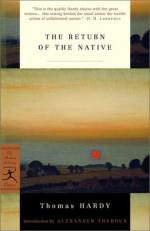Yeobright went round to the door and entered.
“I was so alarmed!” said Thomasin, smiling from one to the other. “I couldn’t believe that he had got white of his own accord! It seemed supernatural.”
“I gave up dealing in reddle last Christmas,” said Venn. “It was a profitable trade, and I found that by that time I had made enough to take the dairy of fifty cows that my father had in his lifetime. I always thought of getting to that place again if I changed at all, and now I am there.”
“How did you manage to become white, Diggory?” Thomasin asked.
“I turned so by degrees, ma’am.”
“You look much better than ever you did before.”
Venn appeared confused; and Thomasin, seeing how inadvertently she had spoken to a man who might possibly have tender feelings for her still, blushed a little. Clym saw nothing of this, and added good-humouredly—
“What shall we have to frighten Thomasin’s baby with, now you have become a human being again?”
“Sit down, Diggory,” said Thomasin, “and stay to tea.”
Venn moved as if he would retire to the kitchen, when Thomasin said with pleasant pertness as she went on with some sewing, “Of course you must sit down here. And where does your fifty-cow dairy lie, Mr. Venn?”
“At Stickleford—about two miles to the right of Alderworth, ma’am, where the meads begin. I have thought that if Mr. Yeobright would like to pay me a visit sometimes he shouldn’t stay away for want of asking. I’ll not bide to tea this afternoon, thank’ee, for I’ve got something on hand that must be settled. ’Tis Maypole-day tomorrow, and the Shadwater folk have clubbed with a few of your neighbours here to have a pole just outside your palings in the heath, as it is a nice green place.” Venn waved his elbow towards the patch in front of the house. “I have been talking to Fairway about it,” he continued, “and I said to him that before we put up the pole it would be as well to ask Mrs. Wildeve.”
“I can say nothing against it,” she answered. “Our property does not reach an inch further than the white palings.”
“But you might not like to see a lot of folk going crazy round a stick, under your very nose?”
“I shall have no objection at all.”
Venn soon after went away, and in the evening Yeobright strolled as far as Fairway’s cottage. It was a lovely May sunset, and the birch trees which grew on this margin of the vast Egdon wilderness had put on their new leaves, delicate as butterflies’ wings, and diaphanous as amber. Beside Fairway’s dwelling was an open space recessed from the road, and here were now collected all the young people from within a radius of a couple of miles. The pole lay with one end supported on a trestle, and women were engaged in wreathing it from the top downwards with wildflowers. The instincts of merry England lingered on here with exceptional vitality, and the symbolic customs which tradition has attached to each season of the year were yet a reality on Egdon. Indeed, the impulses of all such outlandish hamlets are pagan still: in these spots homage to nature, self-adoration, frantic gaieties, fragments of Teutonic rites to divinities whose names are forgotten, seem in some way or other to have survived mediaeval doctrine.




